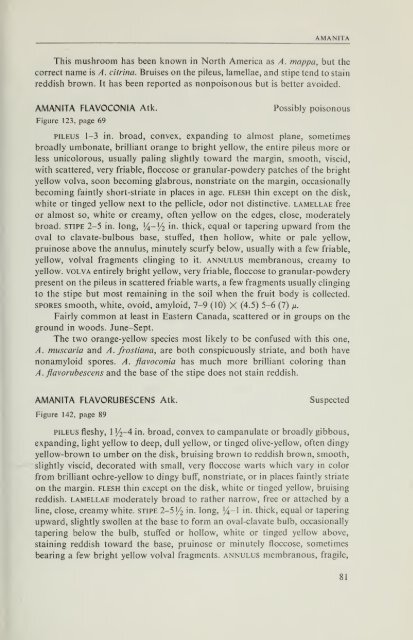You also want an ePaper? Increase the reach of your titles
YUMPU automatically turns print PDFs into web optimized ePapers that Google loves.
AMANITA<br />
This mushroom has been known in North America as A. mappa, but the<br />
correct name is A. citrina. Bruises on the pileus, lamellae, and stipe tend to stain<br />
reddish brown. It has been reported as nonpoisonous but is better avoided.<br />
AMANITA FLAVOCONIA Atk. Possibly poisonous<br />
Figure 123, page 69<br />
PILEUS 1-3 in. broad, convex, expanding to almost plane, sometimes<br />
broadly umbonate, brilliant orange to bright yellow, the entire pileus more or<br />
less unicolorous, usually paling slightly toward the margin, smooth, viscid,<br />
with scattered, very friable, floccose or granular-powdery patches of the bright<br />
yellow volva, soon becoming glabrous, nonstriate on the margin, occasionally<br />
becoming faintly short-striate in places in age. flesh thin except on the disk,<br />
white or tinged yellow next to the pellicle, odor not distinctive, lamellae free<br />
or almost so, white or creamy, often yellow on the edges, close, moderately<br />
broad, stipe 2-5 in. long, V^-Vi in. thick, equal or tapering upward from the<br />
oval to clavate-bulbous base, stuffed, then hollow, white or pale yellow,<br />
pruinose above the annulus, minutely scurfy below, usually with a few friable,<br />
yellow, volval fragments clinging to it. annulus membranous, creamy to<br />
yellow. VOLVA entirely bright yellow, very friable, floccose to granular-powdery<br />
present on the pileus in scattered friable warts, a few fragments usually clinging<br />
to the stipe but most remaining in the soil when the fruit body is collected.<br />
spores smooth, white, ovoid, amyloid, 7-9 (10) X (4.5) 5-6 (7) m-<br />
Fairly common at least in Eastern Canada, scattered or in groups on the<br />
ground in woods. June-Sept.<br />
The two orange-yellow species most hkely to be confused with this one,<br />
A. muscaria and A. frostiana, are both conspicuously striate, and both have<br />
nonamyloid spores. A. flavoconia has much more brilhant coloring than<br />
A.flavorubescens and the base of the stipe does not stain reddish.<br />
AMANITA FLAVORUBESCENS Atk. Suspected<br />
Figure 142, page 89<br />
PILEUS fleshy, 1 1/^-4 in. broad, convex to campanulate or broadly gibbous,<br />
expanding, hght yellow to deep, dull yellow, or tinged olive-yellow, often dingy<br />
yellow-brown to umber on the disk, bruising brown to reddish brown, smooth,<br />
slightly viscid, decorated with small, very floccose warts which vary in color<br />
from brilhant ochre-yellow to dingy buff", nonstriate, or in places faintly striate<br />
on the margin, flesh thin except on the disk, white or tinged yellow, bruising<br />
reddish, lamellae moderately broad to rather narrow, free or attached by a<br />
line, close, creamy white, stipe 2-55/2 in. long, y^-\ in. thick, equal or tapering<br />
upward, sHghtly swollen at the base to form an oval-clavate bulb, occasionally<br />
tapering below the bulb, stuffed or hollow, white or tinged yellow above,<br />
staining reddish toward the base, pruinose or minutely floccose, sometimes<br />
bearing a few bright yellow volval fragments, annulus membranous, fragile,<br />
81

















